System Analysis and Design for Desklib Online Library
VerifiedAdded on 2023/06/09
|12
|1598
|302
AI Summary
This article provides a detailed system analysis and design for Desklib, an online library for study material with solved assignments, essays, dissertation, etc. It includes use case diagrams, class diagrams, sequence diagrams, activity diagrams, and bibliography.
Contribute Materials
Your contribution can guide someone’s learning journey. Share your
documents today.
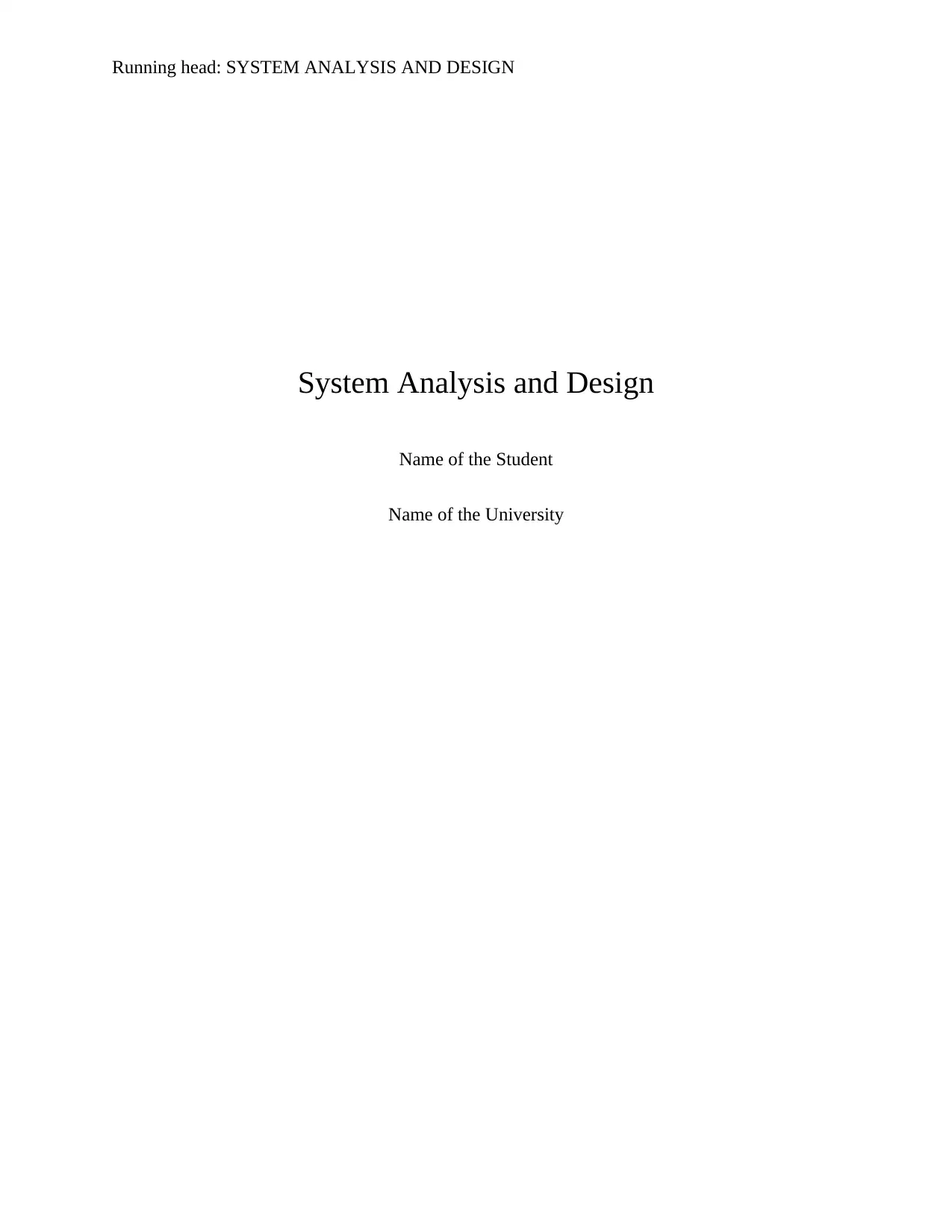
Running head: SYSTEM ANALYSIS AND DESIGN
System Analysis and Design
Name of the Student
Name of the University
System Analysis and Design
Name of the Student
Name of the University
Secure Best Marks with AI Grader
Need help grading? Try our AI Grader for instant feedback on your assignments.
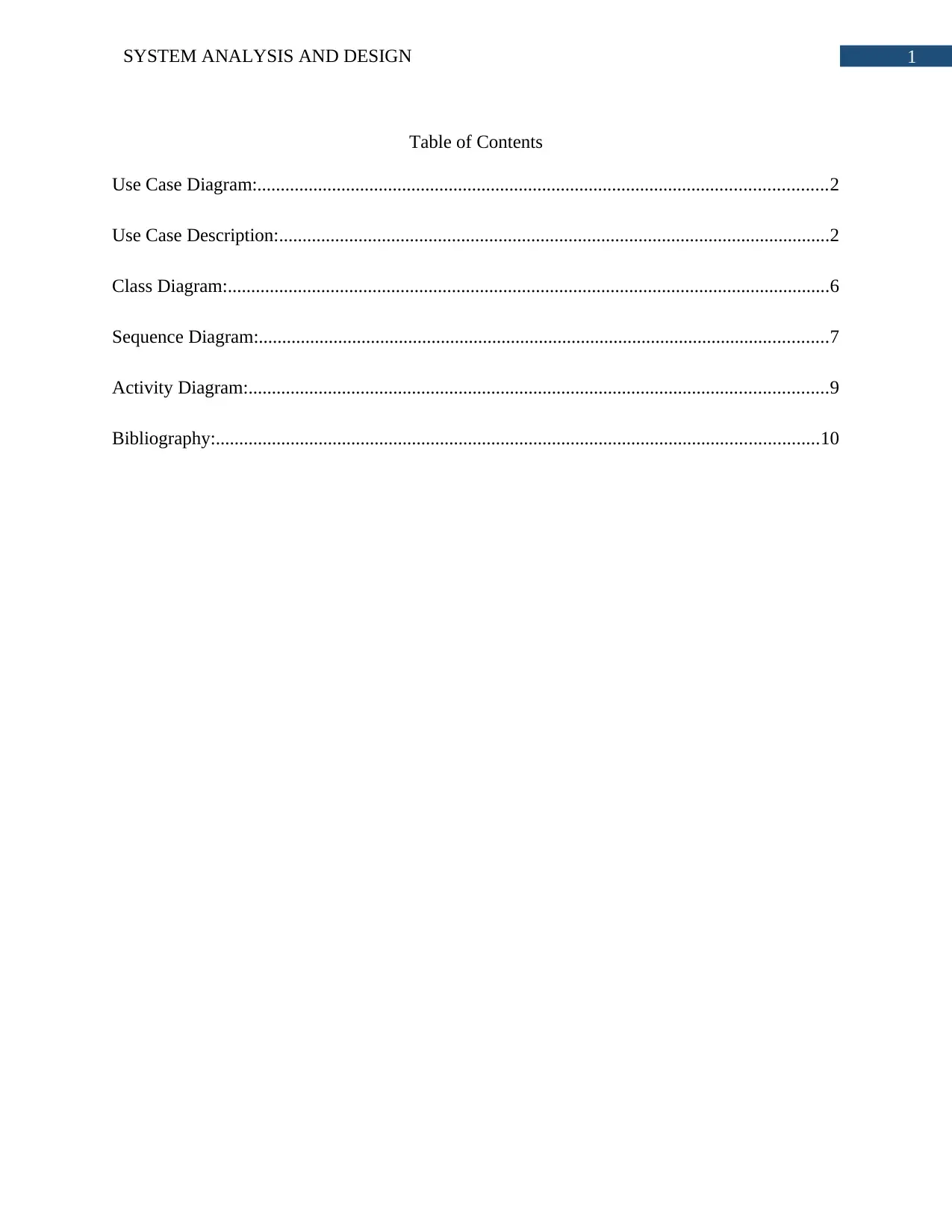
1SYSTEM ANALYSIS AND DESIGN
Table of Contents
Use Case Diagram:..........................................................................................................................2
Use Case Description:......................................................................................................................2
Class Diagram:.................................................................................................................................6
Sequence Diagram:..........................................................................................................................7
Activity Diagram:............................................................................................................................9
Bibliography:.................................................................................................................................10
Table of Contents
Use Case Diagram:..........................................................................................................................2
Use Case Description:......................................................................................................................2
Class Diagram:.................................................................................................................................6
Sequence Diagram:..........................................................................................................................7
Activity Diagram:............................................................................................................................9
Bibliography:.................................................................................................................................10
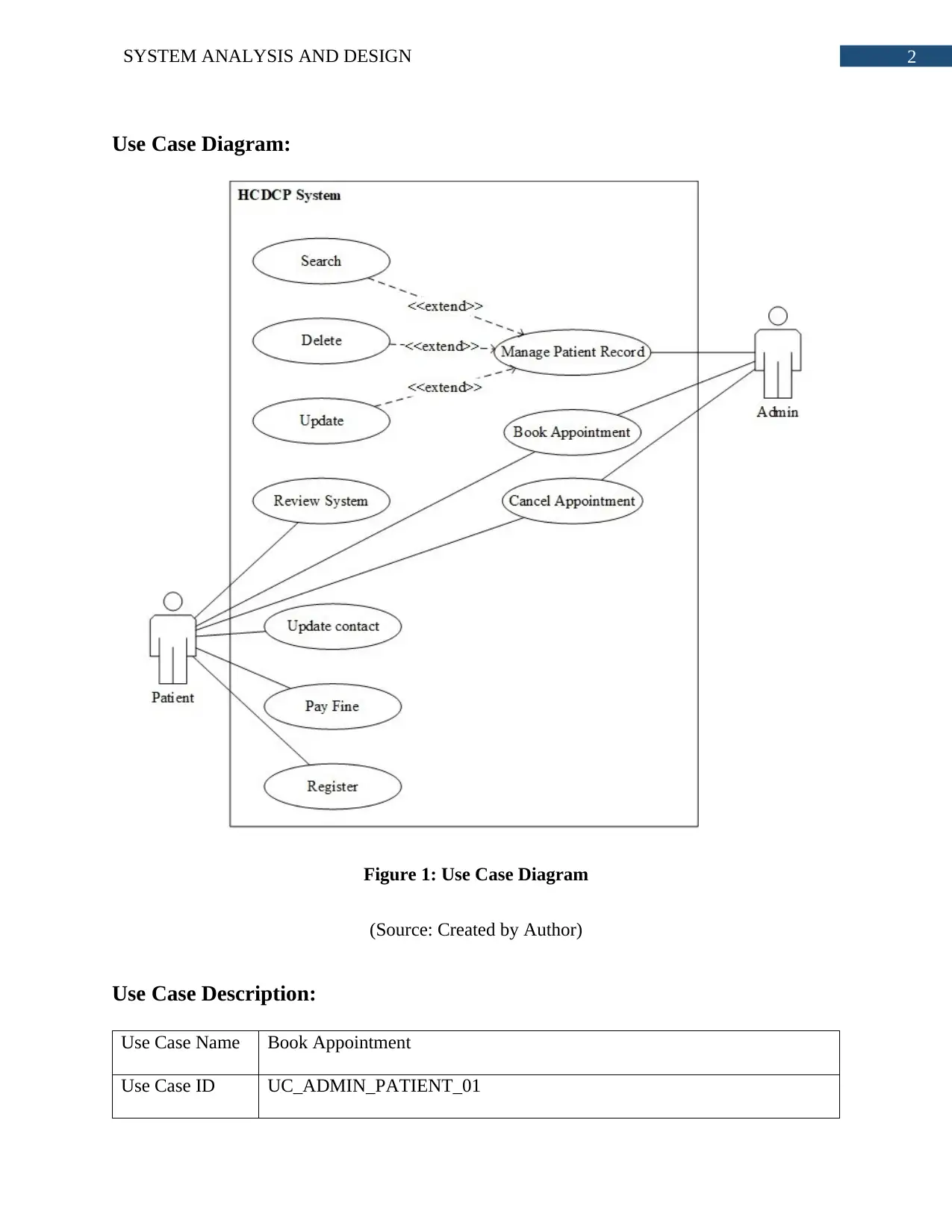
2SYSTEM ANALYSIS AND DESIGN
Use Case Diagram:
Figure 1: Use Case Diagram
(Source: Created by Author)
Use Case Description:
Use Case Name Book Appointment
Use Case ID UC_ADMIN_PATIENT_01
Use Case Diagram:
Figure 1: Use Case Diagram
(Source: Created by Author)
Use Case Description:
Use Case Name Book Appointment
Use Case ID UC_ADMIN_PATIENT_01
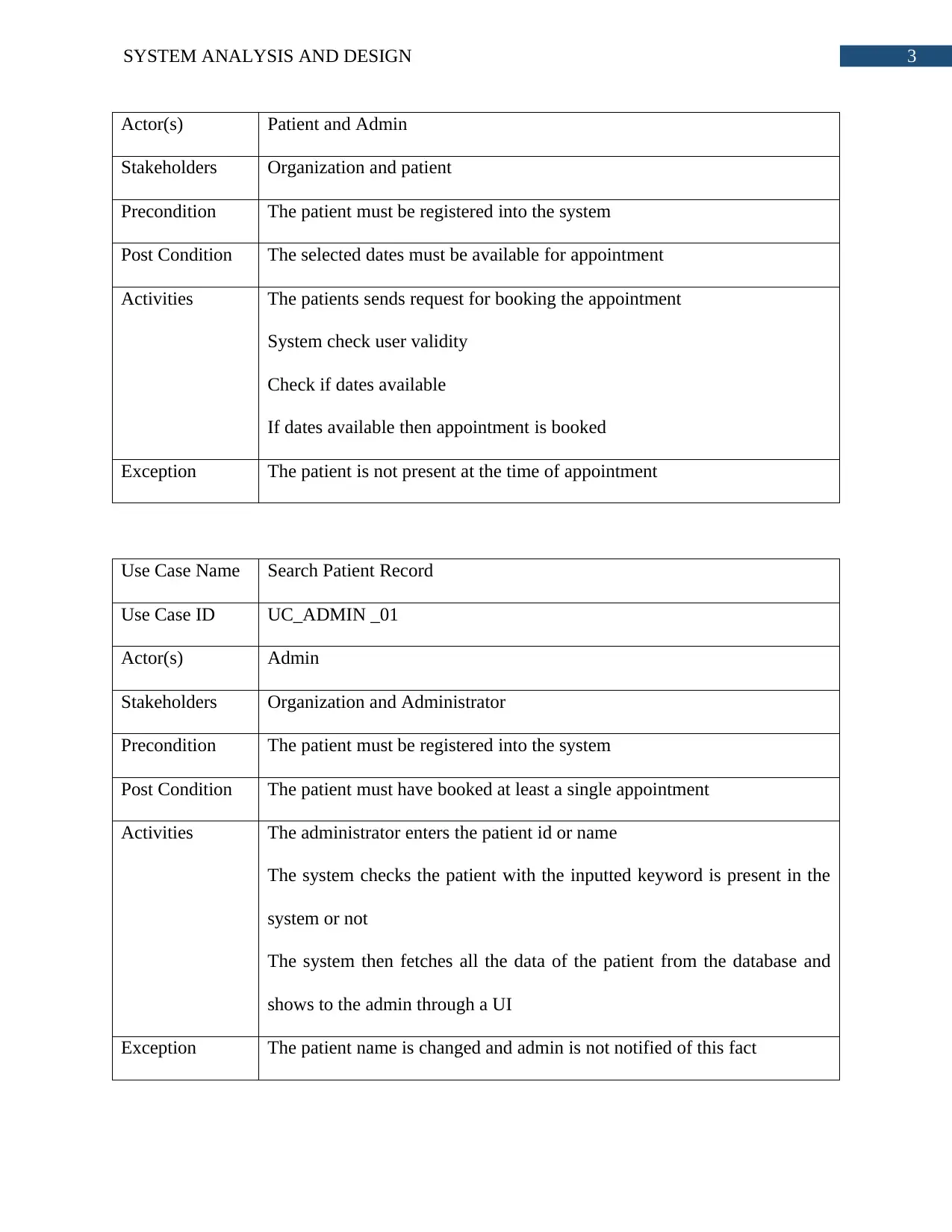
3SYSTEM ANALYSIS AND DESIGN
Actor(s) Patient and Admin
Stakeholders Organization and patient
Precondition The patient must be registered into the system
Post Condition The selected dates must be available for appointment
Activities The patients sends request for booking the appointment
System check user validity
Check if dates available
If dates available then appointment is booked
Exception The patient is not present at the time of appointment
Use Case Name Search Patient Record
Use Case ID UC_ADMIN _01
Actor(s) Admin
Stakeholders Organization and Administrator
Precondition The patient must be registered into the system
Post Condition The patient must have booked at least a single appointment
Activities The administrator enters the patient id or name
The system checks the patient with the inputted keyword is present in the
system or not
The system then fetches all the data of the patient from the database and
shows to the admin through a UI
Exception The patient name is changed and admin is not notified of this fact
Actor(s) Patient and Admin
Stakeholders Organization and patient
Precondition The patient must be registered into the system
Post Condition The selected dates must be available for appointment
Activities The patients sends request for booking the appointment
System check user validity
Check if dates available
If dates available then appointment is booked
Exception The patient is not present at the time of appointment
Use Case Name Search Patient Record
Use Case ID UC_ADMIN _01
Actor(s) Admin
Stakeholders Organization and Administrator
Precondition The patient must be registered into the system
Post Condition The patient must have booked at least a single appointment
Activities The administrator enters the patient id or name
The system checks the patient with the inputted keyword is present in the
system or not
The system then fetches all the data of the patient from the database and
shows to the admin through a UI
Exception The patient name is changed and admin is not notified of this fact
Secure Best Marks with AI Grader
Need help grading? Try our AI Grader for instant feedback on your assignments.
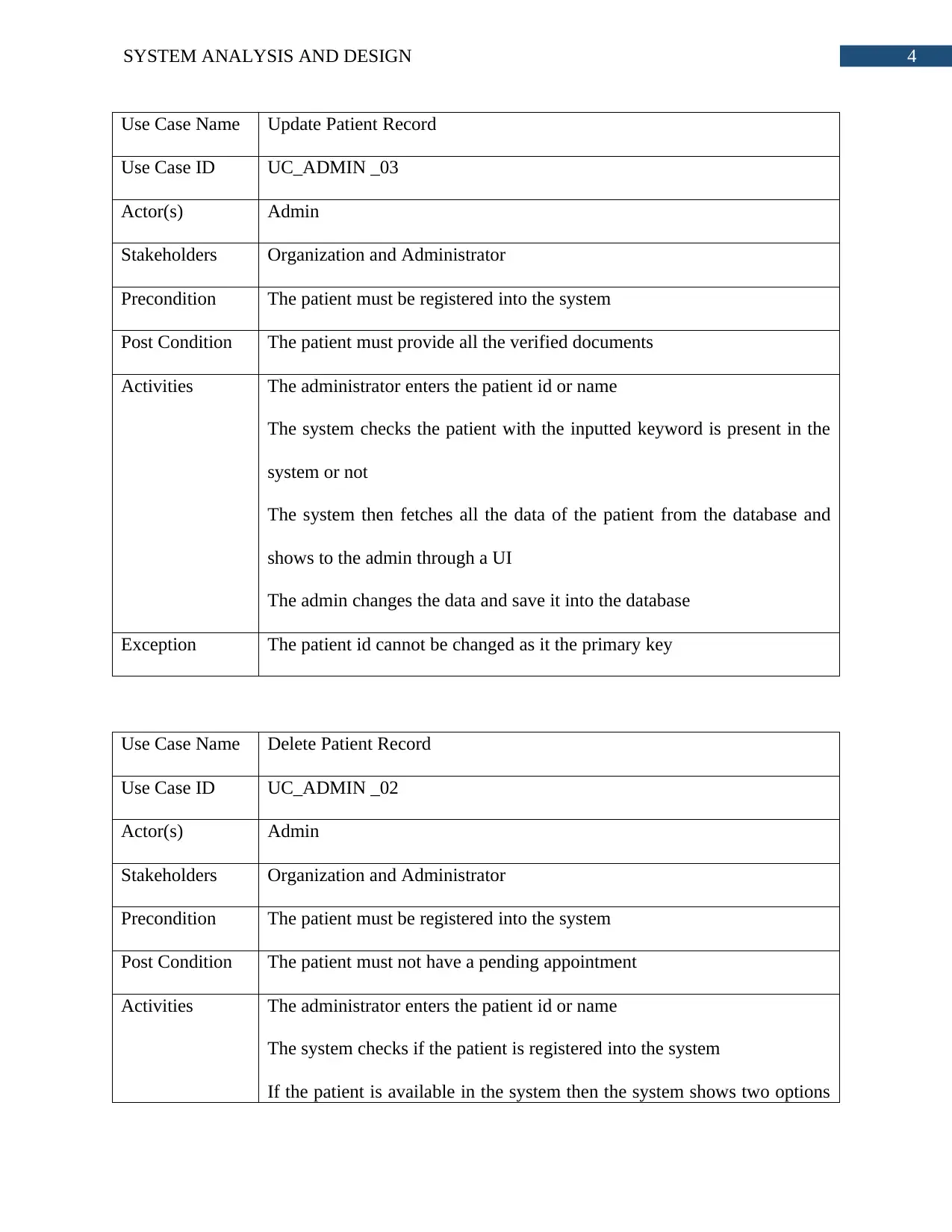
4SYSTEM ANALYSIS AND DESIGN
Use Case Name Update Patient Record
Use Case ID UC_ADMIN _03
Actor(s) Admin
Stakeholders Organization and Administrator
Precondition The patient must be registered into the system
Post Condition The patient must provide all the verified documents
Activities The administrator enters the patient id or name
The system checks the patient with the inputted keyword is present in the
system or not
The system then fetches all the data of the patient from the database and
shows to the admin through a UI
The admin changes the data and save it into the database
Exception The patient id cannot be changed as it the primary key
Use Case Name Delete Patient Record
Use Case ID UC_ADMIN _02
Actor(s) Admin
Stakeholders Organization and Administrator
Precondition The patient must be registered into the system
Post Condition The patient must not have a pending appointment
Activities The administrator enters the patient id or name
The system checks if the patient is registered into the system
If the patient is available in the system then the system shows two options
Use Case Name Update Patient Record
Use Case ID UC_ADMIN _03
Actor(s) Admin
Stakeholders Organization and Administrator
Precondition The patient must be registered into the system
Post Condition The patient must provide all the verified documents
Activities The administrator enters the patient id or name
The system checks the patient with the inputted keyword is present in the
system or not
The system then fetches all the data of the patient from the database and
shows to the admin through a UI
The admin changes the data and save it into the database
Exception The patient id cannot be changed as it the primary key
Use Case Name Delete Patient Record
Use Case ID UC_ADMIN _02
Actor(s) Admin
Stakeholders Organization and Administrator
Precondition The patient must be registered into the system
Post Condition The patient must not have a pending appointment
Activities The administrator enters the patient id or name
The system checks if the patient is registered into the system
If the patient is available in the system then the system shows two options
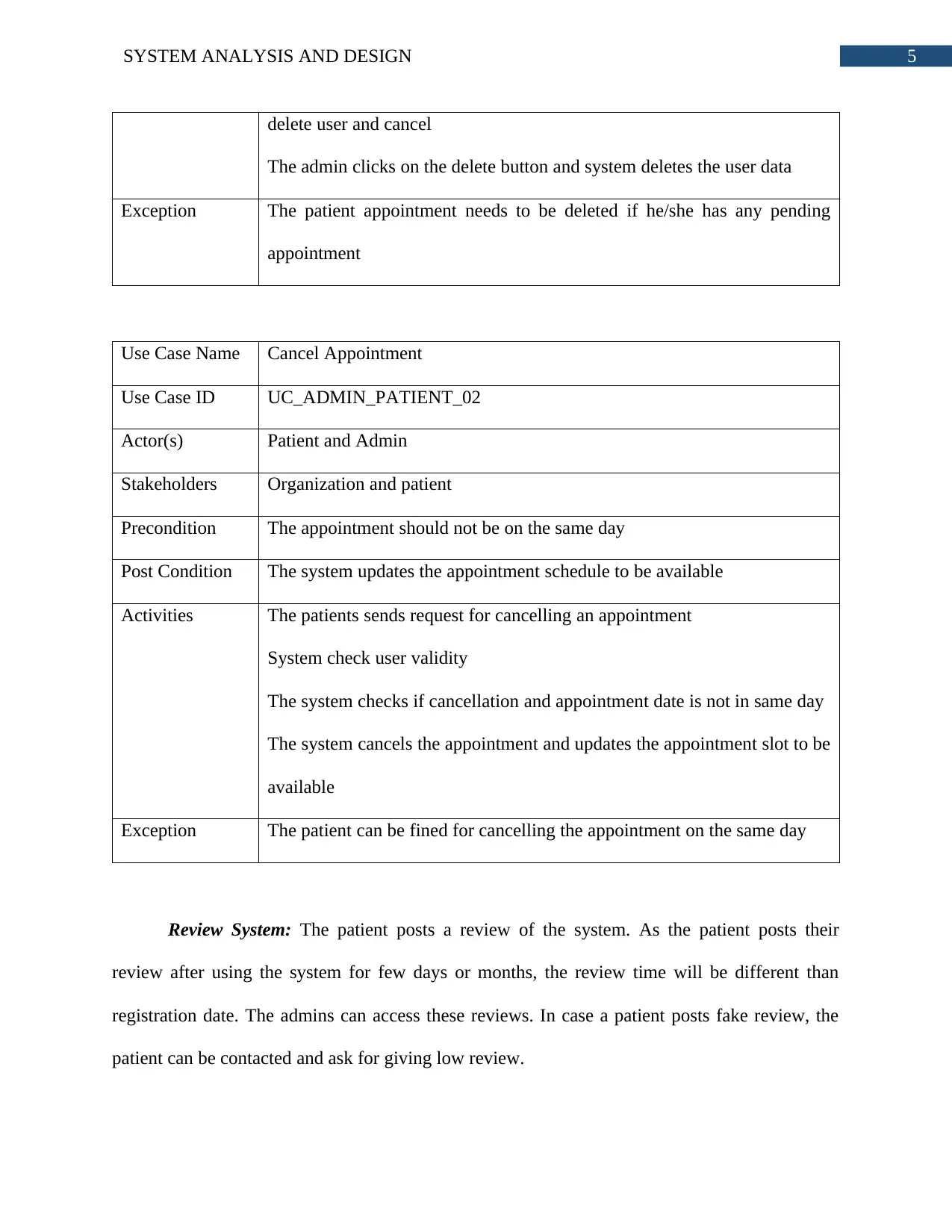
5SYSTEM ANALYSIS AND DESIGN
delete user and cancel
The admin clicks on the delete button and system deletes the user data
Exception The patient appointment needs to be deleted if he/she has any pending
appointment
Use Case Name Cancel Appointment
Use Case ID UC_ADMIN_PATIENT_02
Actor(s) Patient and Admin
Stakeholders Organization and patient
Precondition The appointment should not be on the same day
Post Condition The system updates the appointment schedule to be available
Activities The patients sends request for cancelling an appointment
System check user validity
The system checks if cancellation and appointment date is not in same day
The system cancels the appointment and updates the appointment slot to be
available
Exception The patient can be fined for cancelling the appointment on the same day
Review System: The patient posts a review of the system. As the patient posts their
review after using the system for few days or months, the review time will be different than
registration date. The admins can access these reviews. In case a patient posts fake review, the
patient can be contacted and ask for giving low review.
delete user and cancel
The admin clicks on the delete button and system deletes the user data
Exception The patient appointment needs to be deleted if he/she has any pending
appointment
Use Case Name Cancel Appointment
Use Case ID UC_ADMIN_PATIENT_02
Actor(s) Patient and Admin
Stakeholders Organization and patient
Precondition The appointment should not be on the same day
Post Condition The system updates the appointment schedule to be available
Activities The patients sends request for cancelling an appointment
System check user validity
The system checks if cancellation and appointment date is not in same day
The system cancels the appointment and updates the appointment slot to be
available
Exception The patient can be fined for cancelling the appointment on the same day
Review System: The patient posts a review of the system. As the patient posts their
review after using the system for few days or months, the review time will be different than
registration date. The admins can access these reviews. In case a patient posts fake review, the
patient can be contacted and ask for giving low review.
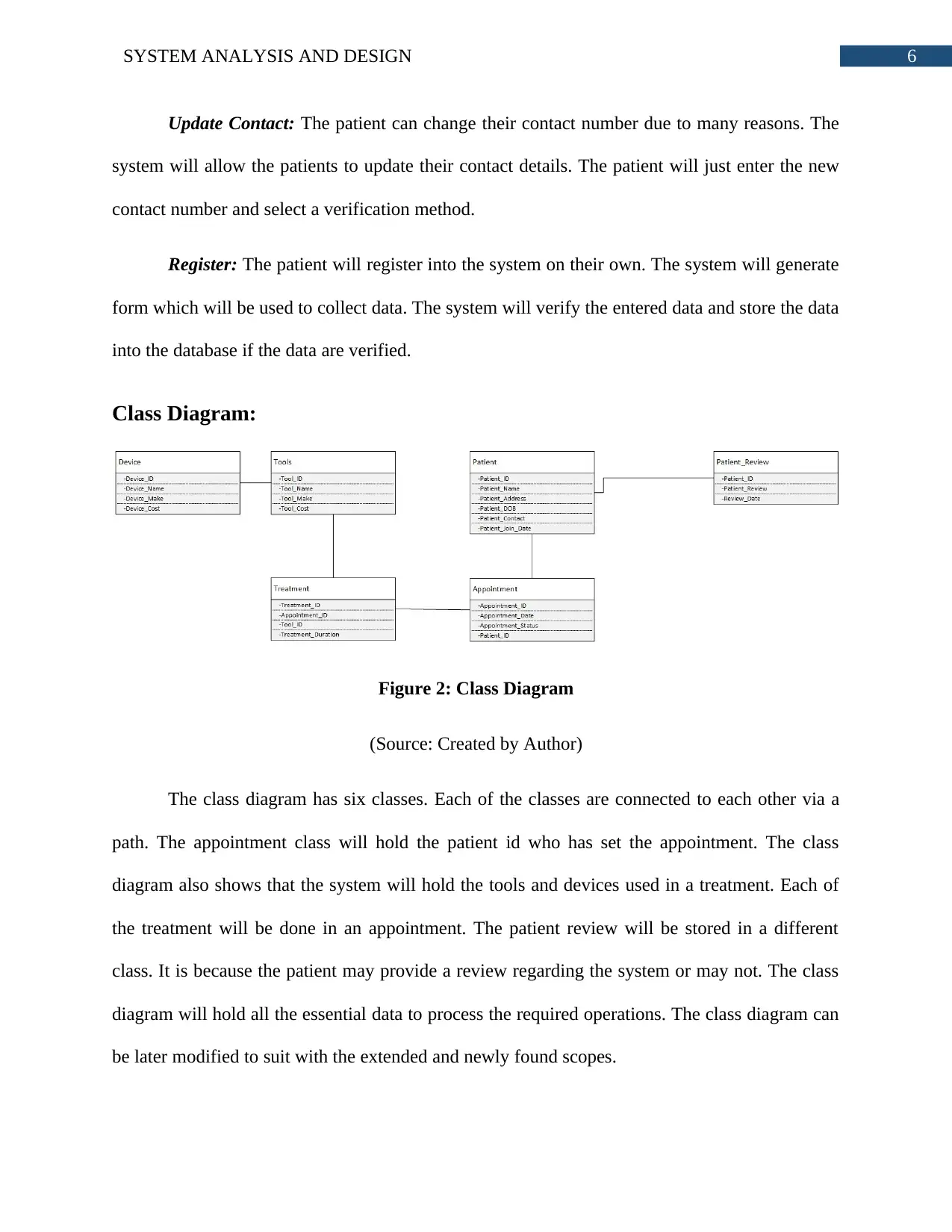
6SYSTEM ANALYSIS AND DESIGN
Update Contact: The patient can change their contact number due to many reasons. The
system will allow the patients to update their contact details. The patient will just enter the new
contact number and select a verification method.
Register: The patient will register into the system on their own. The system will generate
form which will be used to collect data. The system will verify the entered data and store the data
into the database if the data are verified.
Class Diagram:
Figure 2: Class Diagram
(Source: Created by Author)
The class diagram has six classes. Each of the classes are connected to each other via a
path. The appointment class will hold the patient id who has set the appointment. The class
diagram also shows that the system will hold the tools and devices used in a treatment. Each of
the treatment will be done in an appointment. The patient review will be stored in a different
class. It is because the patient may provide a review regarding the system or may not. The class
diagram will hold all the essential data to process the required operations. The class diagram can
be later modified to suit with the extended and newly found scopes.
Update Contact: The patient can change their contact number due to many reasons. The
system will allow the patients to update their contact details. The patient will just enter the new
contact number and select a verification method.
Register: The patient will register into the system on their own. The system will generate
form which will be used to collect data. The system will verify the entered data and store the data
into the database if the data are verified.
Class Diagram:
Figure 2: Class Diagram
(Source: Created by Author)
The class diagram has six classes. Each of the classes are connected to each other via a
path. The appointment class will hold the patient id who has set the appointment. The class
diagram also shows that the system will hold the tools and devices used in a treatment. Each of
the treatment will be done in an appointment. The patient review will be stored in a different
class. It is because the patient may provide a review regarding the system or may not. The class
diagram will hold all the essential data to process the required operations. The class diagram can
be later modified to suit with the extended and newly found scopes.
Paraphrase This Document
Need a fresh take? Get an instant paraphrase of this document with our AI Paraphraser
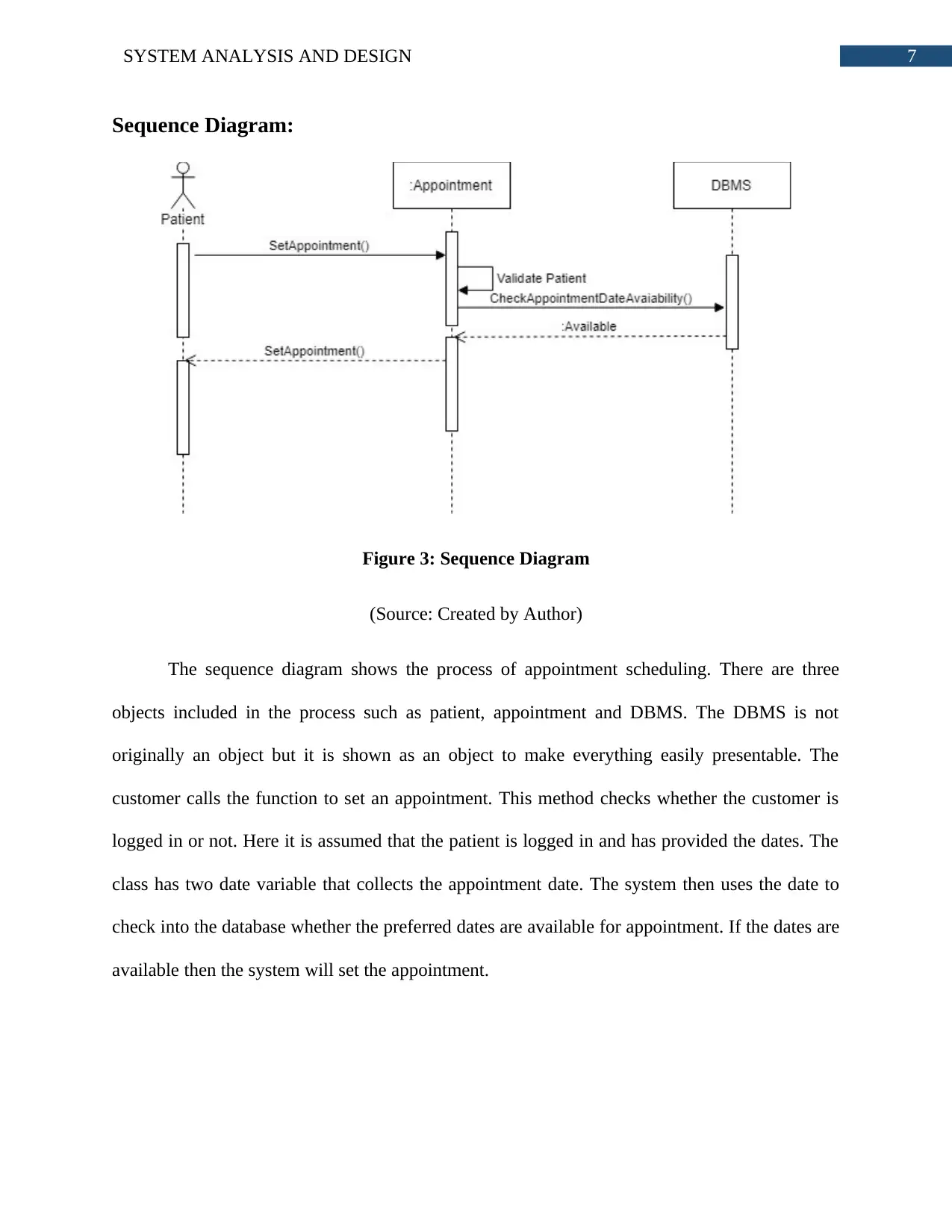
7SYSTEM ANALYSIS AND DESIGN
Sequence Diagram:
Figure 3: Sequence Diagram
(Source: Created by Author)
The sequence diagram shows the process of appointment scheduling. There are three
objects included in the process such as patient, appointment and DBMS. The DBMS is not
originally an object but it is shown as an object to make everything easily presentable. The
customer calls the function to set an appointment. This method checks whether the customer is
logged in or not. Here it is assumed that the patient is logged in and has provided the dates. The
class has two date variable that collects the appointment date. The system then uses the date to
check into the database whether the preferred dates are available for appointment. If the dates are
available then the system will set the appointment.
Sequence Diagram:
Figure 3: Sequence Diagram
(Source: Created by Author)
The sequence diagram shows the process of appointment scheduling. There are three
objects included in the process such as patient, appointment and DBMS. The DBMS is not
originally an object but it is shown as an object to make everything easily presentable. The
customer calls the function to set an appointment. This method checks whether the customer is
logged in or not. Here it is assumed that the patient is logged in and has provided the dates. The
class has two date variable that collects the appointment date. The system then uses the date to
check into the database whether the preferred dates are available for appointment. If the dates are
available then the system will set the appointment.
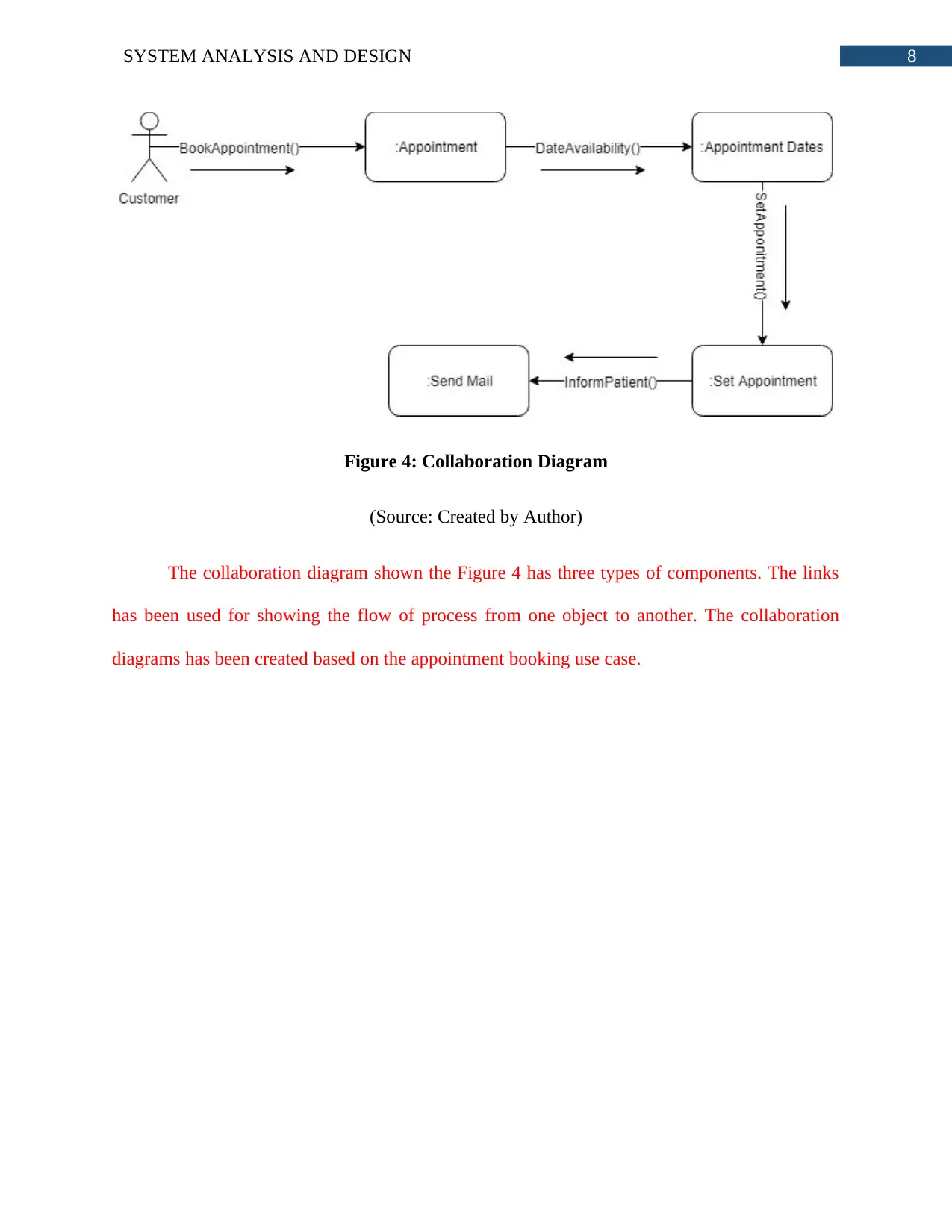
8SYSTEM ANALYSIS AND DESIGN
Figure 4: Collaboration Diagram
(Source: Created by Author)
The collaboration diagram shown the Figure 4 has three types of components. The links
has been used for showing the flow of process from one object to another. The collaboration
diagrams has been created based on the appointment booking use case.
Figure 4: Collaboration Diagram
(Source: Created by Author)
The collaboration diagram shown the Figure 4 has three types of components. The links
has been used for showing the flow of process from one object to another. The collaboration
diagrams has been created based on the appointment booking use case.
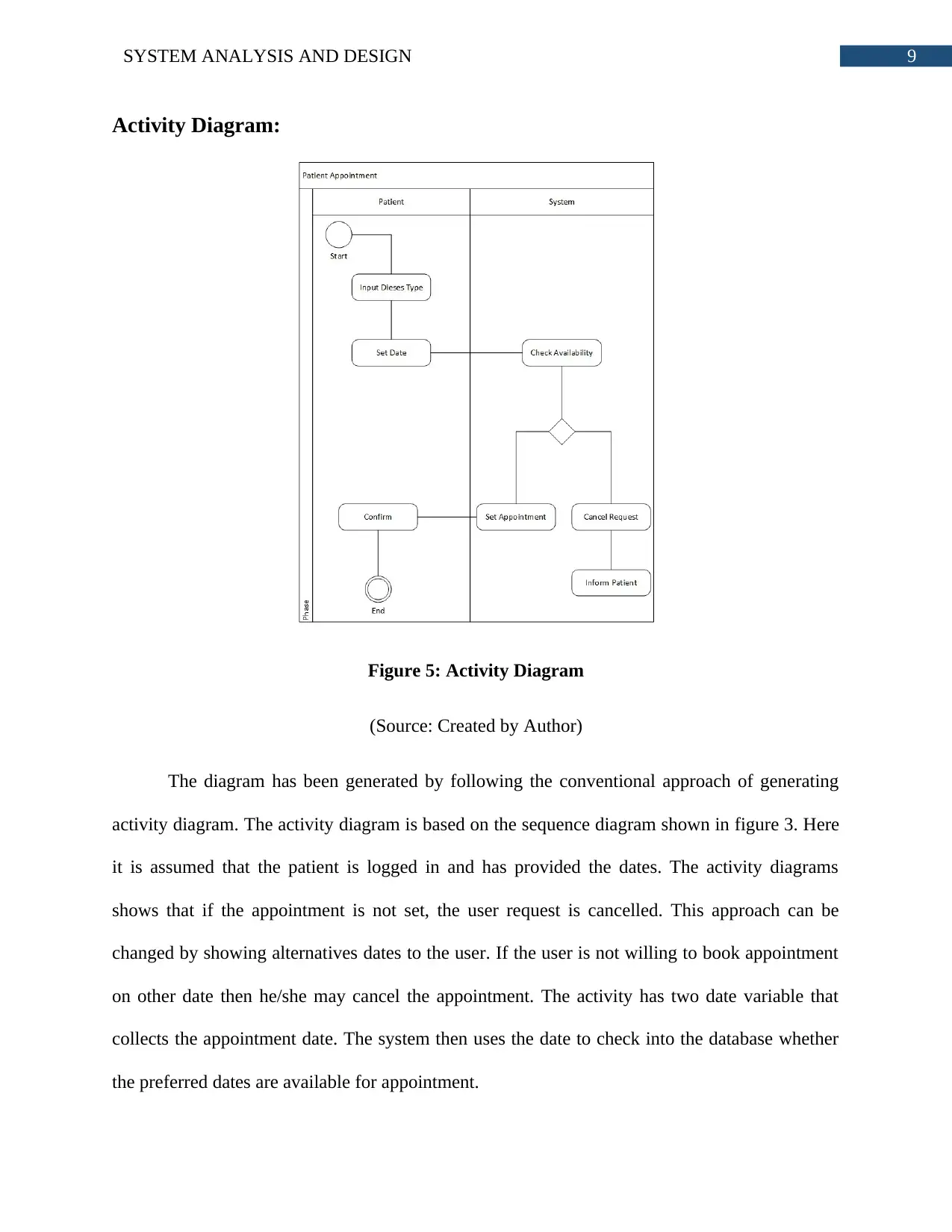
9SYSTEM ANALYSIS AND DESIGN
Activity Diagram:
Figure 5: Activity Diagram
(Source: Created by Author)
The diagram has been generated by following the conventional approach of generating
activity diagram. The activity diagram is based on the sequence diagram shown in figure 3. Here
it is assumed that the patient is logged in and has provided the dates. The activity diagrams
shows that if the appointment is not set, the user request is cancelled. This approach can be
changed by showing alternatives dates to the user. If the user is not willing to book appointment
on other date then he/she may cancel the appointment. The activity has two date variable that
collects the appointment date. The system then uses the date to check into the database whether
the preferred dates are available for appointment.
Activity Diagram:
Figure 5: Activity Diagram
(Source: Created by Author)
The diagram has been generated by following the conventional approach of generating
activity diagram. The activity diagram is based on the sequence diagram shown in figure 3. Here
it is assumed that the patient is logged in and has provided the dates. The activity diagrams
shows that if the appointment is not set, the user request is cancelled. This approach can be
changed by showing alternatives dates to the user. If the user is not willing to book appointment
on other date then he/she may cancel the appointment. The activity has two date variable that
collects the appointment date. The system then uses the date to check into the database whether
the preferred dates are available for appointment.
Secure Best Marks with AI Grader
Need help grading? Try our AI Grader for instant feedback on your assignments.
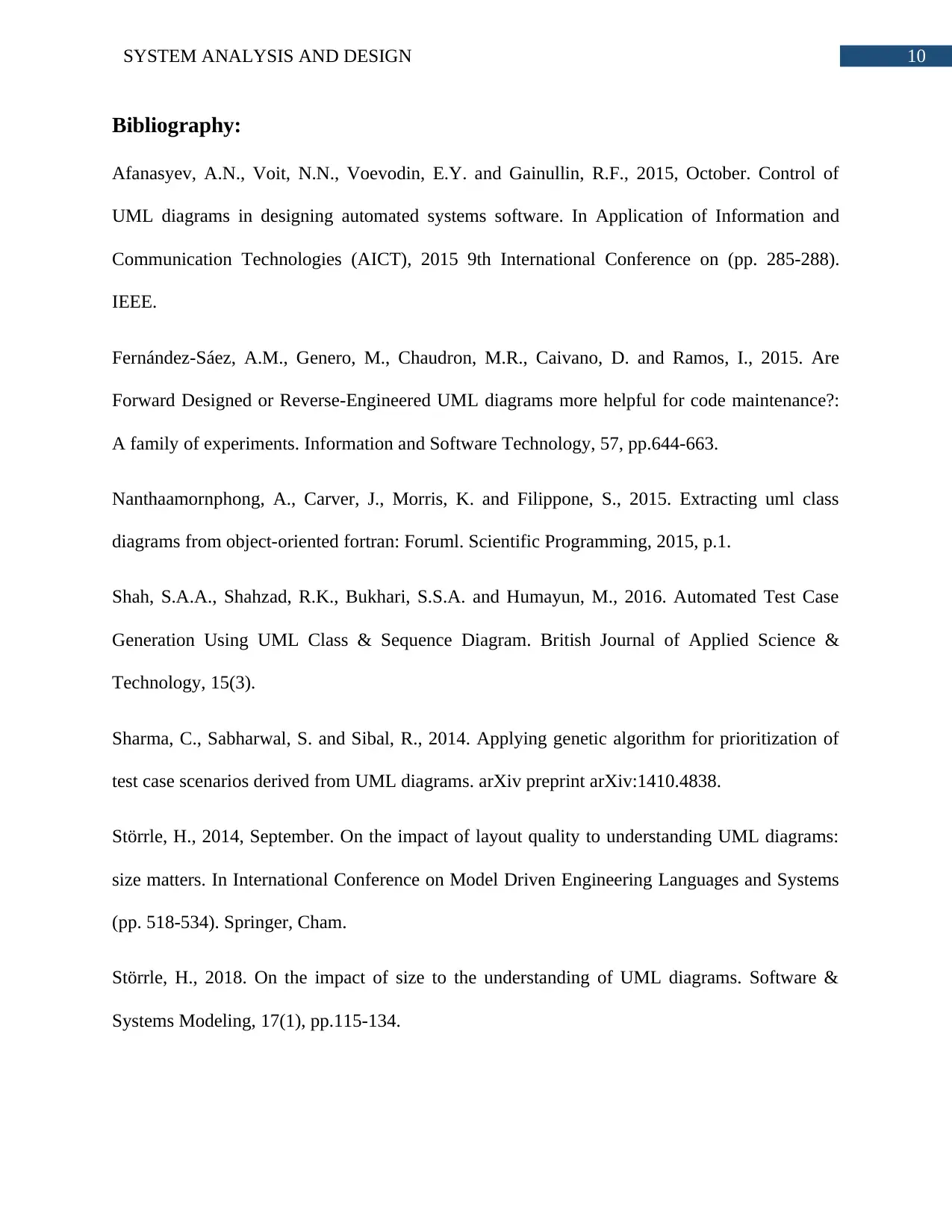
10SYSTEM ANALYSIS AND DESIGN
Bibliography:
Afanasyev, A.N., Voit, N.N., Voevodin, E.Y. and Gainullin, R.F., 2015, October. Control of
UML diagrams in designing automated systems software. In Application of Information and
Communication Technologies (AICT), 2015 9th International Conference on (pp. 285-288).
IEEE.
Fernández-Sáez, A.M., Genero, M., Chaudron, M.R., Caivano, D. and Ramos, I., 2015. Are
Forward Designed or Reverse-Engineered UML diagrams more helpful for code maintenance?:
A family of experiments. Information and Software Technology, 57, pp.644-663.
Nanthaamornphong, A., Carver, J., Morris, K. and Filippone, S., 2015. Extracting uml class
diagrams from object-oriented fortran: Foruml. Scientific Programming, 2015, p.1.
Shah, S.A.A., Shahzad, R.K., Bukhari, S.S.A. and Humayun, M., 2016. Automated Test Case
Generation Using UML Class & Sequence Diagram. British Journal of Applied Science &
Technology, 15(3).
Sharma, C., Sabharwal, S. and Sibal, R., 2014. Applying genetic algorithm for prioritization of
test case scenarios derived from UML diagrams. arXiv preprint arXiv:1410.4838.
Störrle, H., 2014, September. On the impact of layout quality to understanding UML diagrams:
size matters. In International Conference on Model Driven Engineering Languages and Systems
(pp. 518-534). Springer, Cham.
Störrle, H., 2018. On the impact of size to the understanding of UML diagrams. Software &
Systems Modeling, 17(1), pp.115-134.
Bibliography:
Afanasyev, A.N., Voit, N.N., Voevodin, E.Y. and Gainullin, R.F., 2015, October. Control of
UML diagrams in designing automated systems software. In Application of Information and
Communication Technologies (AICT), 2015 9th International Conference on (pp. 285-288).
IEEE.
Fernández-Sáez, A.M., Genero, M., Chaudron, M.R., Caivano, D. and Ramos, I., 2015. Are
Forward Designed or Reverse-Engineered UML diagrams more helpful for code maintenance?:
A family of experiments. Information and Software Technology, 57, pp.644-663.
Nanthaamornphong, A., Carver, J., Morris, K. and Filippone, S., 2015. Extracting uml class
diagrams from object-oriented fortran: Foruml. Scientific Programming, 2015, p.1.
Shah, S.A.A., Shahzad, R.K., Bukhari, S.S.A. and Humayun, M., 2016. Automated Test Case
Generation Using UML Class & Sequence Diagram. British Journal of Applied Science &
Technology, 15(3).
Sharma, C., Sabharwal, S. and Sibal, R., 2014. Applying genetic algorithm for prioritization of
test case scenarios derived from UML diagrams. arXiv preprint arXiv:1410.4838.
Störrle, H., 2014, September. On the impact of layout quality to understanding UML diagrams:
size matters. In International Conference on Model Driven Engineering Languages and Systems
(pp. 518-534). Springer, Cham.
Störrle, H., 2018. On the impact of size to the understanding of UML diagrams. Software &
Systems Modeling, 17(1), pp.115-134.

11SYSTEM ANALYSIS AND DESIGN
Torre, D., Labiche, Y., Genero, M. and Elaasar, M., 2015. UML diagram synthesis techniques: a
systematic mapping study. Carleton University.
Torre, D., Labiche, Y., Genero, M. and Elaasar, M., 2018. A systematic identification of
consistency rules for UML diagrams. Journal of Systems and Software.
Torre, D., Labiche, Y., Genero, M. and Elaasar, M., 2015. UML diagram synthesis techniques: a
systematic mapping study. Carleton University.
Torre, D., Labiche, Y., Genero, M. and Elaasar, M., 2018. A systematic identification of
consistency rules for UML diagrams. Journal of Systems and Software.
1 out of 12
Related Documents
Your All-in-One AI-Powered Toolkit for Academic Success.
+13062052269
info@desklib.com
Available 24*7 on WhatsApp / Email
![[object Object]](/_next/static/media/star-bottom.7253800d.svg)
Unlock your academic potential
© 2024 | Zucol Services PVT LTD | All rights reserved.





